| |||||||
| Founded | 1969 | ||||||
|---|---|---|---|---|---|---|---|
| Ceased operations | 2005 | ||||||
| Operating bases | |||||||
| Frequent-flyer program | EuroBonus | ||||||
| Subsidiaries | |||||||
| Fleet size | 18 (2005) | ||||||
| Destinations | 33 (2005)[1] | ||||||
| Parent company | A. P. Møller–Mærsk Group | ||||||
| Headquarters | Dragør Municipality, Denmark | ||||||
| Website | maersk-air.com | ||||||
Maersk Air A/S was a Danish airline which operated between 1969 and 2005. Owned by the A. P. Møller–Mærsk Group, it operated a mix of scheduled and chartered passenger and cargo services. Headquartered at Dragør, its main operating bases were Copenhagen Airport, Billund Airport and Esbjerg Airport. The airline had offshore helicopter operations from 1975 to 1999 and had three airline subsidiaries: Maersk Air UK, Maersk Commuter, and Star Air.
The airline was founded on the foundations on the purchase of Falck Air on 21 February 1969. Fokker F27s were bought and domestic services from Copenhagen to Odense and Stauning. From 1971 to 1995 Maersk participated in Danair, which held a monopoly on all domestic services. Maersk Air was heavily involved in the inclusive tours market during the 1970s, operating the Boeing 720B and 737-200. From 1981 Maersk started international flights, first out of Billund and from the 1990s out of Copenhagen.
Maersk Air gradually invested in new aircraft, including the Fokker 50, Boeing 737 Classic, and later the 737-700. During the 1990s the number of international services increased, often codesharing with foreign airlines. With the Danish airlines deregulated in 1995, Maersk first sought to compete with Scandinavian Airlines. They later created a cartel. After being exposed, the airline fell into a decline after 2001, posting large deficits from which it never recovered. The airline was bought by the FL Group and merged with Sterling Airlines in 2005.
History
Establishment
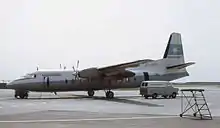
The A. P. Moller-Maersk Group's first investment in aviation was taken in 1937 when it bought a stake in Danish Air Lines, the flag carrier at the time. Its next step took place in 1967, when the group bought a Hawker Siddeley HS 125-3B as a corporate jet.[2] At the time there were few options for Danish airlines. The charter market was dominated by Spies Rejser and Tjæreborgs Rejser, each with their own airlines—Conair and Sterling, respectively. Scandinavian Airlines System (SAS) was the flag carrier and had the sole right to conduct international scheduled services, and freight charters could only be carried out if the entire load had a single shipper and recipient.[3]
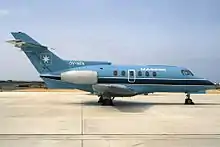
The establishment of the airline was approved by the group in 1969.[4] The airline aimed at ad hoc charter with aircraft in the 50-seat market, and perhaps securing the rights to fly regional scheduled flights to smaller domestic airports.[3] To secure a running organization, Maersk bought Falck Air on 21 February 1969 from the Falck Group. At the time Falck Air operated a fleet of two de Havilland Herons and two Hawker Siddeley HS 748 aircraft and a hangar at Copenhagen Airport, Kastrup.[5] The Herons allowed Maersk to commence services from Copenhagen to Stauning Airport, a route taken over from Cimber Air. Meanwhile, the airline had ordered three Fokker F27 Friendships, the first which was delivered on 9 December.[6] Operations to Odense Airport commenced on 26 December.[7]
The new airline, Maersk Air I/S was officially incorporated on 1 January 1970. The same day it took over the assets in Falk Air along with its air operator's certificate, concessions and the operational responsibility for the HS-125.[7] The initially scheduled operations consisted of five daily trip pairs from Copenhagen to Odense Airport, and two daily pairs to Stauning Airport.[8] Norwegian-American Finn Rassmussen Ryssdal was hired as the airline's first director. He held the position for two years until he was replaced by another Norwegian, Johan Paus, former CEO of Scanair.[9] As part of the establishment, Maersk entered the travel agency industry. Originally named Maersk Air Rejsebureau, was later named Maersk Travel.[10]
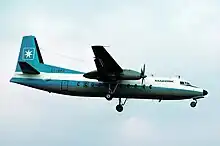
Initial operations
The distribution of domestic routes was a contentious political issue. SAS held a privilege to commence any route they wanted, but lacked regional airlines to serve the smaller airports.[8] It was complicated by the establishment of alternative domestic airlines in Norway and Sweden, Braathens SAFE and Linjeflyg, respectively.[11] Danish authorities, therefore, asked the three scheduled carriers, SAS, Maersk, and Cimber, to negotiate to see if they could reach an agreement. An agreement was reached in November 1971, whereby the company Danair was established.[8] Flights to Vágar Airport on the Faroe Islands commenced in 1971.[12] Thisted Airport opened in 1971 and Maersk was allocated as the operator. The Thisted and Stauning services were transferred to Cimber Air in 1976, although Maersk continued to operate some services.[13]
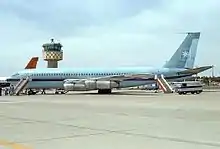
Maersk also aimed at serving the inclusive tours charter market. To gain better access to the market, Maersk bought two travel agents in December 1971, Raffels Rejser and Bangs Rejser. To better target the charter market, Maersk Air bought five used Boeing 720Bs in 1973. This was followed up with purchasing Unisol in 1974 and the three were merged to form a new agency under the brand Unisol and 120,000 annual trips.[14] After having lost 100 million Danish krone (DKK) by 1979, Unison was sold to Tjæreborg in 1980. A participating cause was Unisol's inability to profile itself in a market dominated by two high-profile, yet diametrical, owners.[12]
Maersk Air was contracted by Maersk Oil to operate to the latter's oil field in the North Sea. For this purpose, Maersk Air bought two Bell 212 helicopters. The airline stationed these at Esbjerg Airport and they commenced operations on 1 July 1975.[15]
%252C_Maersk_Air_JP5889115.jpg.webp)
Maersk Air took delivery of its first two Boeing 737-200 Advanced in 1976.[16] By 1981 the airline had taken delivery of fourteen aircraft. Some were leased to other carriers, including Guyana Airways, Malaysia Airlines and Tunisair.[17] Others were used charter services, mostly to Danish inclusive tour operators. From 1983 three aircraft were entirely dedicated to this task. This was a highly competitive market, where Maersk had to compete with Conair, Sterling and Scanair, amongst others.[18]
During the second half of the 1970s, Maersk focused on wet leasing their aircraft on the intercontinental market. Contracts included flying pilgrims from Morocco to Mecca and Scandinavians to North America.[19] The 737-200s proved too large for domestic services. The F27s had been sold and the airline, therefore, determined that it needed to procure new turboprops. A decision was made to buy the de Havilland Dash 7, but in the meantime, the airline leased three HS 748s from 1980 to 1981. The first Dash 7 entered revenue service on 13 May 1981.[17]
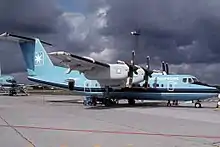
Maersk Air experienced falling profits at during the late 1970s. The revenue of DKK 535 million in 1979 fell to DKK 454 million in 1981, hitting a record loss of DKK 29 million in 1981. The company started hitting problems with liquidity and in 1981 was not able to pay its employees wages. Bjarne Hansen was hired as CEO that year.[20] The number of bases for charter aircraft was reduced, cutting personnel costs. The two Beechcrafts were sold, as were nine other of the airline's twenty-four aircraft.[21] A key part of this plan was not allowing the aircraft to remain idle during the day, thus maximizing revenue.[22] The number of employees were reduced from 720 to 480.[23] By 1985 the revenue had risen to DKK 898 million in 1985, allowing the airline to make a profit of DKK 112 million in 1985.[22]
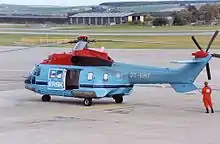
Starting in 1981 Maersk Air started flying a Bell 212 under contract with the Cabinet of the Faroe Islands. By then the helicopter fleet had reached five Bell 212s. From 1983 the petroleum activity increased and two larger Eurocopter AS332 Super Pumas.[24]
Danair was reorganized from 27 September 1982. SAS's routes to Aalborg, Aarhus, and Rønne were taken into the Danair pool. Maersk on its side increased the number of departures on its services. The goal was to improve profitability. And although the scheme did rise passenger numbers, it failed to improve Maersk Air's financial performance in the domestic market.[25] Stauning was dropped from Maersk and Danair's scheduled from 1 January 1983.[26] From 1988 Maersk Air saw competition on its scheduled service to the Faroes, through the establishment of Atlantic Airways.[27]
International
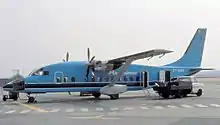
Maersk decided to look for possibilities to fly international routes. The first non-SAS international concession was in 1981 granted to Air Business from Esbjerg via Thistedt to Stavanger Airport, Sola in Norway, using an Embraer EMB-110 Bandeirante. Maersk Air bought the company in 1984 and bought two Short 360s. Soon the change to the concession was granted allowing the flight to operate from Aalborg instead of Thistedt, allowing for a greater catchment of passengers. The airline was kept as a regional subsidiary and took the name Maersk Commuter in 1988. It was dissolved in 1990.[28]
Changes in European Community rules in 1984 allowed any carrier to operate intra-European routes, granted that they connected two regional airports. Maersk laid its eyes on Billund Airport, which was centrally located in Jutland and was classified as a regional airport. It was already a popular base for charter flights.[29] London was a favored destination, but all the four primary airports were all categorized as primary airports. To exploit the new regulations, Maersk identified London Southend Airport, which was classified as a secondary airport.[30] Maersk inaugurated the route on 29 November 1984 with two round trips,[30] using Dash 7s. Due to the distance from the city Maersk could only market it as "London" if they included an onwards ticket with a train. The route carried about 12,000 passengers annually and failed to make a profit.[31]
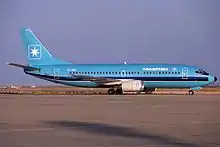
Maersk considered both Århus and Billund as the base for their Jutland operations, and settled for Billund.[32] The next international route to inaugurate was to Cologne Bonn Airport in Germany in 1988, in cooperation with Lufthansa. It was flown with the Fokker 50, which had just entered into service with the airline.[33] During the late 1980s Maersk Air started an expansion of its travel agencies, both domestically and abroad.[10]
Based on the need for a replacement for the 737-200s, Boeing developed the shortened 737-500 on the request of Maersk and others. Maersk took delivery of its first -500 on 6 April 1990.[33] From 1990 Maersk was free to compete on any intra-European international route. Using the new -500s, it focused on routes out of Billund, providing services to Amsterdam Airport Schiphol, Brussels Airport, London Gatwick Airport, Stockholm Arlanda Airport and Stavanger. In addition it flew from Copenhagen to London.[33]
New airlines
Maersk Air Cargo, which only acted as a handling agent, was founded in 1982. Maersk Air was barred from operating a cargo fleet until deregulation in 1987. The Maersk Group then established Star Air. It took into use a fleet of F-27-600s.[34] From 1993 it acquired a fleet of Boeing 727-100s and started hauling for United Parcel Service.[35]
Maersk Air also decided to enter the British market. It bought part of the Plimsoll Line, which again bought Birmingham Executive Airways (BEA) and Brymon Airways.[36] After a merger into Brymon European Airways and subsequent demerger, Maersk Air UK was founded on the foundations of BEA. It operated a series of international and domestic services out of Birmingham Airport, initially with a fleet of three Jetstream 31 and three BAC One-Elevens.[37] Maersk signed a franchise agreement in which Maersk Air UK would fly with British Airways livery and flight codes, but at their own expense and their own aircraft and crew.[38] The 1-11s were replaced with Boeing 737-500s in 1996.[39] Bombardier CRJ200s were introduced two years later.[40]
Maersk also secured a 49-percent stake in Estonian Air,[41] after having beaten SAS in a privatization tender.[42] Two of Maersk Air's Fokker 50s were leased to Estonian Air,[43] who also took delivery of two 737-500s, replacing the older Soviet fleet.[41]
Danish deregulation
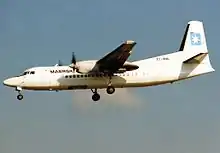
Maersk Air began services from Billund to Frankfurt in 1993,[44] and a year later it started flights from Copenhagen to Kristiansand.[45] To meet the upcoming deregulation, Maersk carried out a major fleet rearrangement in 1993. The airline sold its Fokker 50s and leased them back. Meanwhile, it procured six Boeing 737-500s, which were delivered in 1996.[44]
Unlike Cimber, Maersk initially declined to participate in SAS' frequent-flyer program, EuroBonus, which was founded in 1992.[46] With the demise of Danair, Maersk Air focused on improving its international connections. Its primary strategy was to establish routes from Billund to European destinations with codeshare agreements with major European airlines. Gradually the services were upgraded from Fokker 50 to 737-500s.[47] Danair was dissolved on 1 October 1995, when the domestic airline industry in Denmark was deregulated.[48]
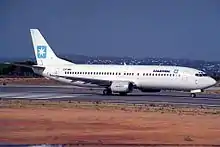
Maersk's success in Jutland was noticed by SAS, who in October 1996 opened its first service out of Billund, to Frankfurt.[49] This was the first route in which the two airlines competed for head to head. In response, Maersk Air commenced services out of SAS' stronghold at Copenhagen Airport to Milan, Geneva and Stockholm the following year.[50] Additional routes out of Billund were added in 1997.[45] Flemming Knudsen took the position as CEO on 12 January 1998. On 3 March the first 737-700 was delivered,[51] with Maersk Air being the European launch customer.[52]
With its eight daily round trips, Maersk Air only captured ten percent of the market on the Copenhagen–Stockholm route, losing money on it. Maersk, therefore, started negotiations with British Airways and KLM to see if they could become part of an airline alliance. They were in close negotiations with what would become Oneworld, but pulled out in the last minute.[53]
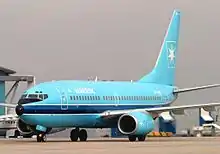
With the 14 June 1998 opening of the Great Belt Fixed Link, car, coach and rail transport became faster between Jutland and Funen on the one hand, and Zealand on the other, cutting travel time by an hour.[46] This had an effect on patronage, with a significant drop in domestic traffic.[54] The same year the government introduced a domestic air tax of DKK 150 on all domestic flights, which further contributed to the fall in domestic ridership. Maersk Air anticipated a significant drop and reduced services from a 737-500 to a Fokker 50. Yet passenger numbers dropped to a third and the service was terminated on 13 June 1998.[55] Ole Dietz took over as managing director on 1 March 1999.[56]
After the Oneworld negotiations failed, Maersk Air turned to SAS in an attempt to initiate a cooperation.[57] Negotiations commenced in early 1997,[58] and the deal was announced on 8 October 1998,[59] and took effect 28 March 1999. Maersk would adopt EuroBonus and codeshare all domestic flights, flights out of Copenhagen and select Billund services.[60] In addition to the publicly stated clauses, the agreement also contained a series of illegal collusions. Maersk and SAS split up the market between them, so they no longer would fly on competing routes. This involved that Maersk Air would withdraw from its Copenhagen services to Stockholm and Geneva. Maersk Air also agreed to—gradually so to not awake suspicion—withdraw from its various codeshare agreements with other airlines than SAS.[61]
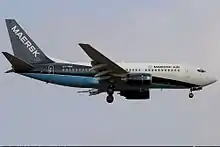
The case was followed up by the EU Commission and the Danish authorities,[62] who carried out a dawn raid on 15 June 2000.[63] Maersk Air was sentenced to a fine of €17.5 million, while SAS was fined €43.75 million.[64] As a consequence, Dietz resigned as CEO and Hansen, who had been appointed chairman, also withdrew.[65] Flemming Ipsen was hired as a new CEO, while Troels Dilling was hired as chairman.[66]
Decline
Maersk was struck by a series of labor disputes in 1998 and 1999.[67] At the turn of the century Maersk Air fell into financial distress. The airline was struck hard by the 2001 airline recession, making a loss that year of DKK 341 million.[68] Ridership increased in 2002, largely through the increased sale of discounted tickets.[69] Maersk Air therefore turned to divest its non-core activities. Estonian Air was sold to SAS in 2003.[69] The British subsidiary lost an accumulative DKK 325 million from 2000 through 2002. The company was therefore sold in a management buyout in 2003, with the airline becoming Duo Airways.[70]
The Maersk Group was forced to issue more than DKK 700 million in the airline from 2002 to 2005.[68] In late 2003 the Maersk Aircraft A/S was established to own the fleet, spurring speculation in the media that Maersk was planning of liquidating the company. The year gave a net loss of DKK 841 million.[71]
In the years following the cartel case, almost the entire executive management of the airline was replaced. A large portion of the new management was without experience from the aviation industry.[72] On 1 November 2003 Ipsen was replaced as CEO by Finn Øelund, who came from the same position in Air Greenland. He devised a new strategy, in which the airline would better utilize its fleet by placing flights closer to each other and flying throughout the day. He also proposed competing head-on with SAS, as he believed that Maersk Air with the new strategy could operate with lower costs than the consortium.[73] Aircraft received a new white and dark blue livery, replacing the old light-blue Maersk colors.[74] The airline adopted the slogan "fly as you like" and focused its route production on typical holiday destinations and cheap fares.[75]
Since 2002 Maersk had seen competition in the scheduled market from Sterling, which had reorganized itself as a low-cost carrier targeting the Mediterranean leisure market. In 2005 Fred. Olsen & Co. sold the airline to FL Group.[76] The Maersk Group announced on 30 June 2005 that it would sell Maersk Air to Sterling.[76] Star Air and the corporate jet were kept out of the deal. Ownership of the 737 was also not included, and instead, there were leased to Sterling.[77] The sales price of Maersk Air was never made public.[78]
Operations
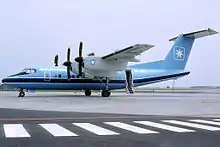
Maersk Air I/S was until 1996 organized as a partnership (interessentskab), which was again owned by two subsidiaries within the Maersk Group. This allowed the company to report less detailed accounts, and hindered competitors from gaining as good a picture of the company's economic situation.[79] Maersk Air I/S was reorganized in 1996. The partnership model was abandoned and instead, the airline became a limited company (aktieselskab) directly under the mother company. Star Air on its side became a subsidiary of Maersk Air.[79]
Half of Maersk Air's accumulative profits came from the sale of used aircraft. Inspired form the importance of crucial timing of purchase and sale of ships, Maersk Air made several advantages deals. One of the involved selling 737-200s at a higher price than they had paid for them. Maersk was an early customer of the Fokker 50, of which the first was delivered in 1988. As part of the purchase agreement, they would receive DKK one million per sold aircraft in the Nordic Counties. This turned out well as SAS and Braathens SAFE bought a combined twenty units.[17]

From 1974 to 1999 Maersk Air operated a helicopter division out of Esbjerg Airport. These were contracted by Maersk Oil, which operated offshore oil platforms in the North Sea.[80]
Throughout its existence, Maersk Air operated a corporate jet for the Maersk Group. Five different aircraft were used in series, first consisting of two Hawker Siddeley HS 125,[2] since 1997 opting for a Bombardier Challenger 600.[81][82] These were all named Jette Maersk and served two purposes. First, they were used for flying executives. Secondly, the aircraft were dispatched to send mechanics and spare parts of serve ships of Maersk Line and other shipping companies within the group. Because this could minimize downtime due to mechanical failure, the latter proved a highly profitable endeavor.[83]
Ground handling
_(2).jpg.webp)
Initially, Maersk and the other major Danish airlines had a common ground handling company, Copenhagen Air Services, at the eponymous airport. In 1994 Maersk Air bought out the other owners of Copenhagen Air Services. Within three years it was making a DKK 46-million profit from a DKK 401-million revenue. In 1998 Maersk merged the company with the ground handling company owned by the Swedish Civil Aviation Administration, creating Novia. It operated ground handling services at the airports in Copenhagen, Stockholm-Arlanda and Gothenburg-Landvetter.[84]
With the deregulation of the handling market from 1999, entranced with lower costs took over a substantial portion of the market. Novia failed to retain its profits and lost DKK 80 million from 1999 to 2001. The CAA sold to Aviapartner in 2001, but the cooperation was poor.[85] Maersk Air eventually let the company be file for bankruptcy.[70]
Subsidiary airlines
SAS held a 51-percent share of the company, while Maersk received 34 percent and Cimber 15 percent. Initially, it was to organize domestic flights and in the long run become a separate operator. Danair bought services from the three airlines, who retained flights to their respective destinations. Then Danair would set prices and sell tickets on the flights and the profits were paid out in relation to the ownership shares. The airlines were paid a fixed price, irrespective of their actual operating costs.[8]
Maersk Commuter was based at Esbjerg Airport and operated as a subsidiary of Maersk Air between 1984 and 1990. It flew a single route, from Esbjerg via Aalborg to Stavanger.[13] It operated a fleet of two Short 360s.[86]
Maersk Air UK operated in the United Kingdom between 1993 and 2003. It operated under a franchise agreement with British Airways with its base at Birmingham Airport. It employed the BA branding, including aircraft livery, uniforms, in-flight service, and catering, as well as terminal services. It also employed BA's flight codes and reservation system. Flights qualified for miles on BA's frequent-flyer program, Executive Club.[38]
Star Air was from 1996 to 2004 a cargo airline subsidiary of Maersk Air. It operated a fleet of cargo jetliners, notably the Boeing 727 and Boeing 757, on long-term contracts with United Parcel Service. These operations were based in UPS's main European hub at Cologne Bonn Airport in Germany.[87]
A 49-percent stake in Estonian Air was owned by Maersk Air between 1996 and 2003. The flag carrier of Estonia was based at Tallinn Airport and flew a limited international network, using a combination of Boeing 737-500s and Fokker 50s.[41]
Travel agencies
As part of the establishment, Maersk entered the travel agency industry. Originally named Maersk Air Rejsebureau, this department was later named Maersk Travel. It bought Expert Rejser in 1987 and established international agencies in London, Hong Kong, and Singapore. It gradually built up a nationwide network of travel agency outlets, in Ålborg, Århus, Copenhagen, Esbjerg, Herning, Horsens, Odense and Skive.[10] In the following years it bought several smaller agencies and in 1990 entered a cooperation with DSB Rejsebureau. A common agency was established in Esbjerg and negotiations regarding a fusion were initiated. But both parent companies wanted to be the "locomotive" in the new company, and the deal fell through.[88] Maersk Travel was merged with DFDS Travel in 1997, to create Maersk DFDS Travel. This proved a difficult process and Maersk pulled out of the new company in 1999.[89]
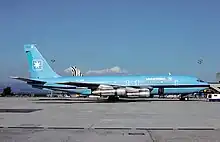
Maersk also aimed at serving the inclusive tours charter market. To gain better access to the market, Maersk bought two travel agents in December 1971, Raffels Rejser and Bangs Rejser. This was followed up with purchasing Unisol in 1974 and the three were merged to form a new agency under the brand Unisol and 120,000 annual trips. Unisol—Denmark's third-largest inclusive tours travel agency—was placed under the industrial department in Maersk, while the airline reported directly to the executive administration. This caused a lack of coordination between the companies and Maersk never made money from the inclusive tours operations.[14] After having lost 100 million Danish krone (DKK) by 1979, Unison was sold to Tjæreborg in 1980.[12]
Fleet
The following is a list of aircraft operated by Maersk Air, including its helicopter and corporate jet divisions. It excludes aircraft operated by Star Air, Maersk Commuter, and Maersk Air UK. The list consists of the total number of aircraft operated by the airline (although the peak number operated may be lower), the year the type was first introduced and the year the last aircraft was taken out of service.
| Aircraft | Qty. | Intr. | Ret. | Ref. |
|---|---|---|---|---|
| Hawker Siddeley HS 125 | 3 | 1967 | 1985 | [90] |
| de Havilland Heron | 2 | 1969 | 1970 | [5] |
| Hawker Siddeley HS 748 | 5 | 1970 | 1981 | [5][17] |
| Fokker F27-100 Friendship | 10 | 1969 | 1996 | [17][34] |
| Boeing 720B | 5 | 1973 | 1981 | [91] |
| Bell 212 | 5 | 1975 | 1993 | [24] |
| Boeing 737-200 Advanced | 14 | 1976 | 1990 | [17] |
| de Havilland Canada DHC-7 Dash 7-102 | 5 | 1981 | 1989 | [17] |
| Eurocopter AS332 Super Puma | 5 | 1983 | 1999 | [24] |
| Boeing 737-300 | 22 | 1985 | 1998 | [92] |
| Eurocopter AS365 Dauphin | 2 | 1983 | 1999 | |
| Fokker 50 | 9 | 1988 | 2000 | [17][93] |
| Boeing 737-400 | 3 | 1993 | 1996 | [92] |
| Boeing 737-500 | 24 | 1990 | 2005 | [92] |
| Bombardier Challenger 604 | 2 | 1997 | 2005 | [81][82] |
| Boeing 737-700 | 15 | 1998 | 2005 | [94] |
| Bombardier CRJ-200 | 11 | 1998 | 2004 | [95] |
Accidents and incidents
Maersk Air has been subject to three write-off accidents, of which one resulted in fatalities:
The first accident took place on 27 December 1969, ten days after the accident aircraft, a Fokker F27 with registration OY-APD, had been delivered to the airline. It was being used for training flight in poor weather conditions at Bornholm Airport. After carrying out a touch and go, the aircraft failed to stay airborne due to icing on the wings. It slid off the runway and into the Baltic Sea.[7][96]
On 25 January 1975 the F27 OY-APB was carrying out a landing on a wet and icy runway at Vágar Airport. Without having been informed of the conditions, the pilots veered the aircraft off the runway and collided with terrain.[97][98]
The fatal accident took place on 2 January 1984. A Bell 212 with registration OY-HMC crashed into the North Sea during a flight from Esbjerg Airport to an oil platform. There arose a breach in the steering system and the pilots lost control of the helicopter. This caused the aircraft to start to spin and the pilots to reduce speed to regain control. This caused a loss of height and eventually brought the helicopter to an emergency landing on the water. Both pilots and a passenger were killed in the crash.[24]
References
- ↑ "Airline Route Maps". www.AirlineRouteMaps.com. Archived from the original on 6 August 2007. Retrieved 1 January 2018.
- 1 2 Ellemose: 42
- 1 2 Ellemose: 49
- ↑ Ellemose: 47
- 1 2 3 Ellemose: 50
- ↑ Ellemose: 51
- 1 2 3 Ellemose: 52
- 1 2 3 4 Ellemose: 62
- ↑ Ellemose: 53
- 1 2 3 Ellemose: 111
- ↑ Buraas: 244
- 1 2 3 Ellemose: 56
- 1 2 Lassen, Claus; Reinau, Kristian Hegnar (2013). "Da Thisted gikk i luften!" (PDF). Artikler fra Trafikdage på Aalborg Universitet (in Danish): 14–16. ISSN 1603-9696.
- 1 2 Ellemose: 55
- ↑ Ellemose: 82
- ↑ Ellemose: 77
- 1 2 3 4 5 6 7 8 Ellemose: 80
- ↑ Ellemose: 78
- ↑ Ellemose: 65
- ↑ Ellemose: 70
- ↑ Ellemose: 71
- 1 2 Ellemose: 86
- ↑ Ellemose: 72
- 1 2 3 4 Ellemose: 83
- ↑ Ellemose: 63
- ↑ Jensen, Allan (2005). "EKVJ fylder 40 år" (PDF). Oscar Yankee (in Danish) (3): 30–36. Archived from the original (PDF) on 2012-08-09.
- ↑ Ellemose: 106
- ↑ Ellemose: 91
- ↑ Ellemose: 94
- 1 2 Ellemose: 95
- ↑ Ellemose: 96
- ↑ Ellemose: 97
- 1 2 3 Ellemose: 98
- 1 2 Ellemose: 100
- ↑ Ellemose: 114
- ↑ Ellemose: 101
- ↑ Ellemose: 104
- 1 2 "BA extends franchise to Brymon/Maersk". Flight International: 14. 11 August 1993. Retrieved 24 September 2014.
- ↑ Ellemose: 105
- ↑ "Maersk orders CRJs to provide 70-seat option". Flight International: 11. 5 November 1997. Retrieved 24 September 2014.
- 1 2 3 Jeziorski, Andrezej (2 July 1997). "Made for each other?". Flight International: 38–40. Retrieved 20 September 2014.
- ↑ Ellemose: 129
- ↑ "Maersk ponders Fokker options". Flight International: 10. 23 October 1996. Retrieved 20 September 2014.
- 1 2 Ellemose: 107
- 1 2 Ellemose: 293
- 1 2 Ellemose: 108
- ↑ Ellemose: 125
- ↑ "Denmark will deregulate, but little will change". Flight International: 14. 27 September 1995. Retrieved 24 September 2014.
- ↑ Ellemose: 130
- ↑ Ellemose: 131
- ↑ Ellemose: 145
- ↑ "Parts shortages slow down Boeing production". Flight International: 11. 15 October 1997. Retrieved 24 September 2014.
- ↑ Ellemose: 149
- ↑ Ellemose: 109
- ↑ Ellemose: 124
- ↑ Ellemose: 158
- ↑ Ellemose: 151
- ↑ Ellemose: 171
- ↑ Ellemose: 150
- ↑ Ellemose: 152
- ↑ Ellemose: 173
- ↑ Ellemose: 168
- ↑ Ellemose: 169
- ↑ Ellemose: 182
- ↑ Ellemose: 187
- ↑ Ellemose: 222
- ↑ Ellemose: 157
- 1 2 Ellemose: 233
- 1 2 Ellemose: 234
- 1 2 Ellemose: 232
- ↑ Ellemose: 235
- ↑ Ellemose: 237
- ↑ Ellemose: 241
- ↑ Ellemose: 245
- ↑ Ellemose: 247
- 1 2 Ellemose: 251
- ↑ Ellemose: 253
- ↑ Ellemose: 254
- 1 2 Ellemose: 122
- ↑ Haylay, Julia (16 May 1987). "Maersk unmasked". Flight International: 34–36. Retrieved 24 September 2014.
- 1 2 "OY-APM". OY-REG. Retrieved 18 September 2014.
- 1 2 "OY-MMM". OY-REG. Retrieved 18 September 2014.
- ↑ Ellemose: 43
- ↑ Ellemose: 230
- ↑ Ellemose: 231
- ↑ "360s for Denmark". Flight International: 1512. 10 December 1983. Retrieved 22 September 2014.
- ↑ "About Us". Star Air. Archived from the original on 21 July 2014. Retrieved 22 September 2014.
- ↑ Ellemose: 112
- ↑ Ellemose: 113
- ↑ Ellemose: 43, 294
- ↑ Ellemose: 55–56
- 1 2 3 "Boeing 737 in Maersk Air history". Airfleets. Retrieved 18 September 2014.
- ↑ "Fokker 50 in Maersk Air history". Airfleets. Retrieved 18 September 2014.
- ↑ "Boeing 737 Next Gen in Maersk Air history". Airfleets. Retrieved 18 September 2014.
- ↑ "Canadair Regional Jet in Maersk Air history". Airfleets. Retrieved 18 September 2014.
- ↑ "Saturday 27 December 1969". Aviation Safety Network. Retrieved 21 September 2014.
- ↑ Ellemose: 57
- ↑ "Saturday 25 January 1975". Aviation Safety Network. Retrieved 21 September 2014.
Bibliography
- Buraas, Anders (1972). Fly over fly: Historien om SAS (in Norwegian). Oslo: Gyldendal Norsk Forlag. ISBN 82-05-00891-4.
- Ellemose, Søren (2009). Luftens helte (in Danish). Aarhus: Jyllands-Posten Forlag. ISBN 978-87-7692-197-2.
.jpg.webp)
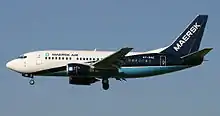
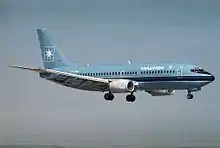
%252C_United_Parcel_Service_(UPS)_JP5926976.jpg.webp)
.jpg.webp)